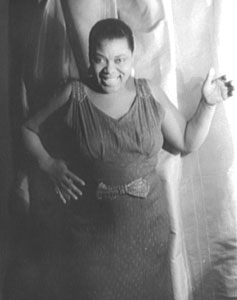
Bessie Smith
Acclaimed blues singer Bessie Smith was born in Chattanooga and lived in a section of the city called Blue Goose Hollow at the foot of Cameron Hill. Her father, William Smith, a part-time Baptist minister, died when Smith was very young, and her mother died when she was nine. That same year, Smith began her career on Ninth Street in Chattanooga, singing and dancing for change to the accompaniment of her brother’s guitar.
In 1912 she joined the touring Rabbit Foot Minstrels, where Gertrude “Ma” Rainey, the mother of all female blues singers, began to tutor her greatest pupil. Smith soon began touring on her own. In 1923 she signed a contract with Columbia Records and recorded “Down Hearted Blues,” which sold 800,000 copies at 75 cents each. It was Columbia’s first big hit and inspired the company to start its “Race Series,” aimed at the African American market.
Billed as “The Empress of the Blues,” Smith soon earned an annual income of $20,000 from her Columbia sales and performed for $1,500 to $2,500 per week on the African American circuit in the northeast and South. She sang with the best musicians of the day, including Louis Armstrong, who played trumpet on nine of her records. Smith wrote many of the songs she recorded, using the themes of poverty, love, and the temptation of alcohol. Her 156 known recordings include such classics as “Pig Foot and Bottle of Beer,” “Beale Street Blues,” “Beale Street Mama,” “Baby Doll,” “Standin’ in the Rain Blues,” “Midnight Steppers,” and “Nobody Knows You When You’re Down and Out.”
Smith cut an imposing figure at 5’9″ and 200 pounds, and her performance attire of satin gowns, headdresses, long strands of pearls, and feather boas became a well-known trademark. In the days before electronic microphones, her booming voice could be heard outside the largest theaters. Her only performance in Chattanooga after achieving stardom produced a memorable story. After her performance at the Liberty Theatre, Smith attended a party given by a friend, where she knocked down a drunken admirer who was pestering her. The would-be admirer then stabbed Smith, who chased him for several blocks before collapsing. She was taken to the hospital but returned to the stage the next night.
Smith’s career declined in the 1930s due to a combination of the Great Depression, alcoholism, and the lack of radio exposure resulting from her suggestive song lyrics. In 1937 Smith was killed in a highway accident outside Clarksdale, Mississippi, while making a comeback tour of the South. Contemporary accounts that she died after being turned away from a “Whites-Only” hospital have proven unfounded, although she did have to wait for a “Blacks-Only” ambulance.
Smith was buried in Sharon Hill, Pennsylvania, near Philadelphia. In 1970 Janis Joplin, who credited her own success to her imitation of Smith’s style, contributed funds to the erection of a gravestone at the burial site. Inscribed on the headstone are the following words: “The greatest blues singer in the world will never stop singing.”
Suggested Reading
Chris Albertson, Bessie (1972)



